Health Advancement and Promotion: Breastfeeding in India Analysis
VerifiedAdded on 2019/11/20
|9
|2365
|64
Report
AI Summary
This report provides a comprehensive review of breastfeeding practices in India, focusing on their impact on infant health and nutrition. It begins with an introduction highlighting the significance of breastfeeding as a natural medicine and its role in combating undernutrition among newborns, a critical issue in India. The report explores the motivation behind the review, which is to address the lack of systematic research on breastfeeding practices in the country, and outlines the methods used to gather relevant research studies. Inclusion and exclusion criteria are defined, followed by a flowchart illustrating the study selection process. The results reveal that breastfeeding practices in India are often poor, with mothers lacking awareness of its benefits. Factors such as education, family support, and cultural influences are discussed as contributing to this issue. The report also examines various strategies implemented to improve breastfeeding rates, including awareness programs and community-based initiatives. The conclusion emphasizes the need for promoting breastfeeding to ensure optimal infant health, prevent preventable deaths, and reduce undernutrition. The report stresses the importance of national policies and effective awareness campaigns to encourage breastfeeding and improve the health and well-being of mothers and children. The report includes a comprehensive list of references. This assignment is contributed by a student to be published on the website Desklib, a platform which provides all the necessary AI based study tools for students.
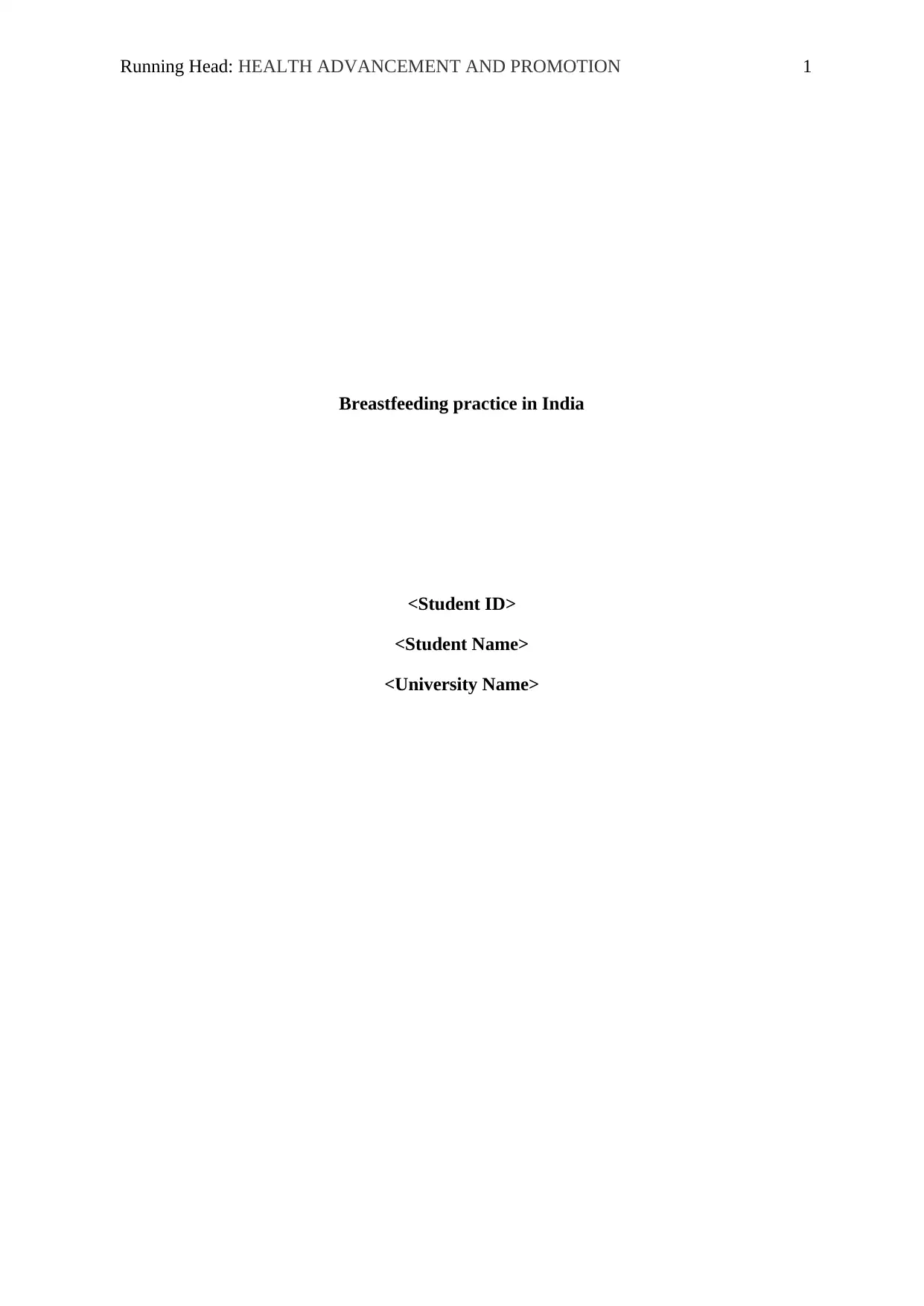
Running Head: HEALTH ADVANCEMENT AND PROMOTION 1
Breastfeeding practice in India
<Student ID>
<Student Name>
<University Name>
Breastfeeding practice in India
<Student ID>
<Student Name>
<University Name>
Paraphrase This Document
Need a fresh take? Get an instant paraphrase of this document with our AI Paraphraser
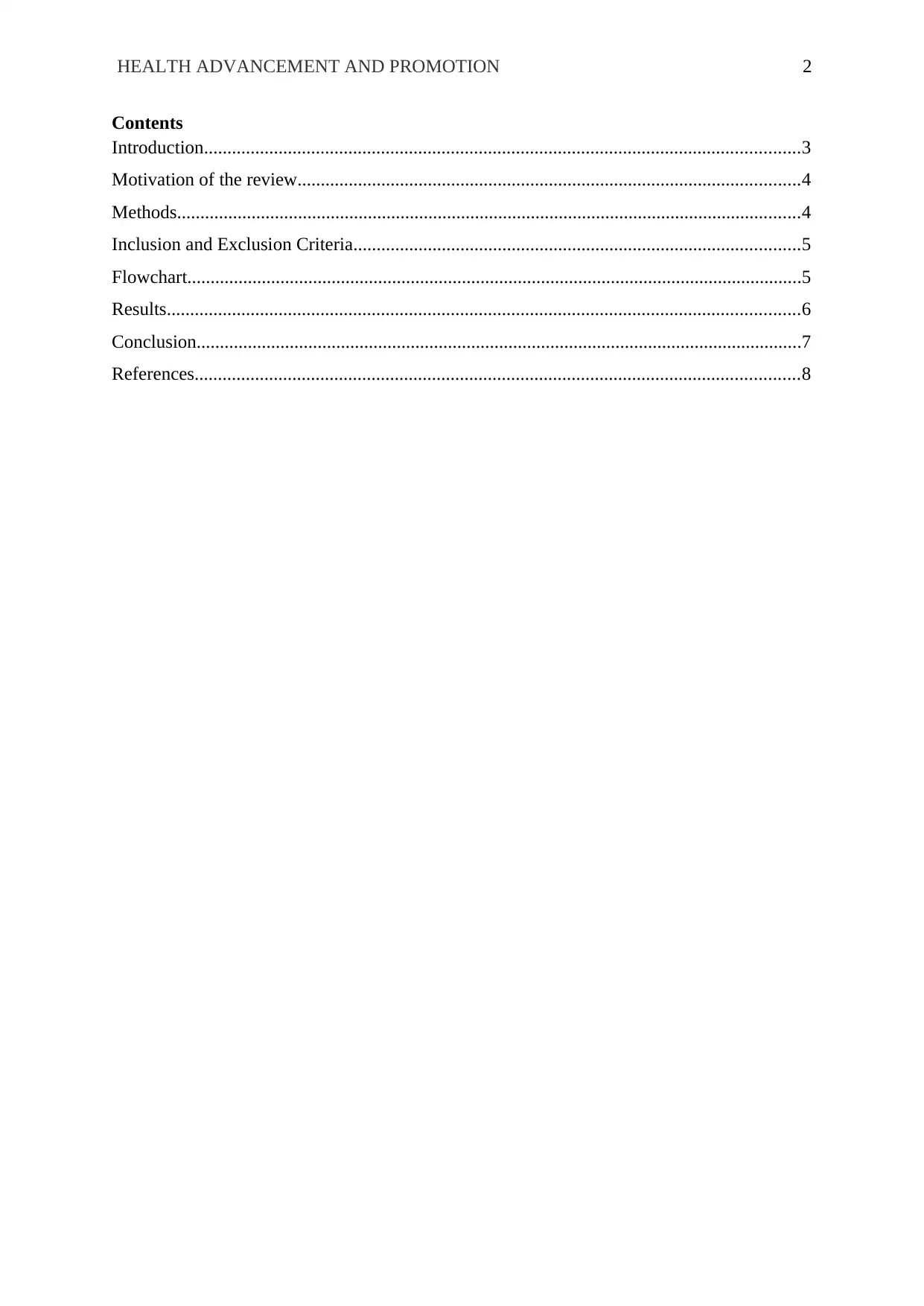
HEALTH ADVANCEMENT AND PROMOTION 2
Contents
Introduction................................................................................................................................3
Motivation of the review............................................................................................................4
Methods......................................................................................................................................4
Inclusion and Exclusion Criteria................................................................................................5
Flowchart....................................................................................................................................5
Results........................................................................................................................................6
Conclusion..................................................................................................................................7
References..................................................................................................................................8
Contents
Introduction................................................................................................................................3
Motivation of the review............................................................................................................4
Methods......................................................................................................................................4
Inclusion and Exclusion Criteria................................................................................................5
Flowchart....................................................................................................................................5
Results........................................................................................................................................6
Conclusion..................................................................................................................................7
References..................................................................................................................................8
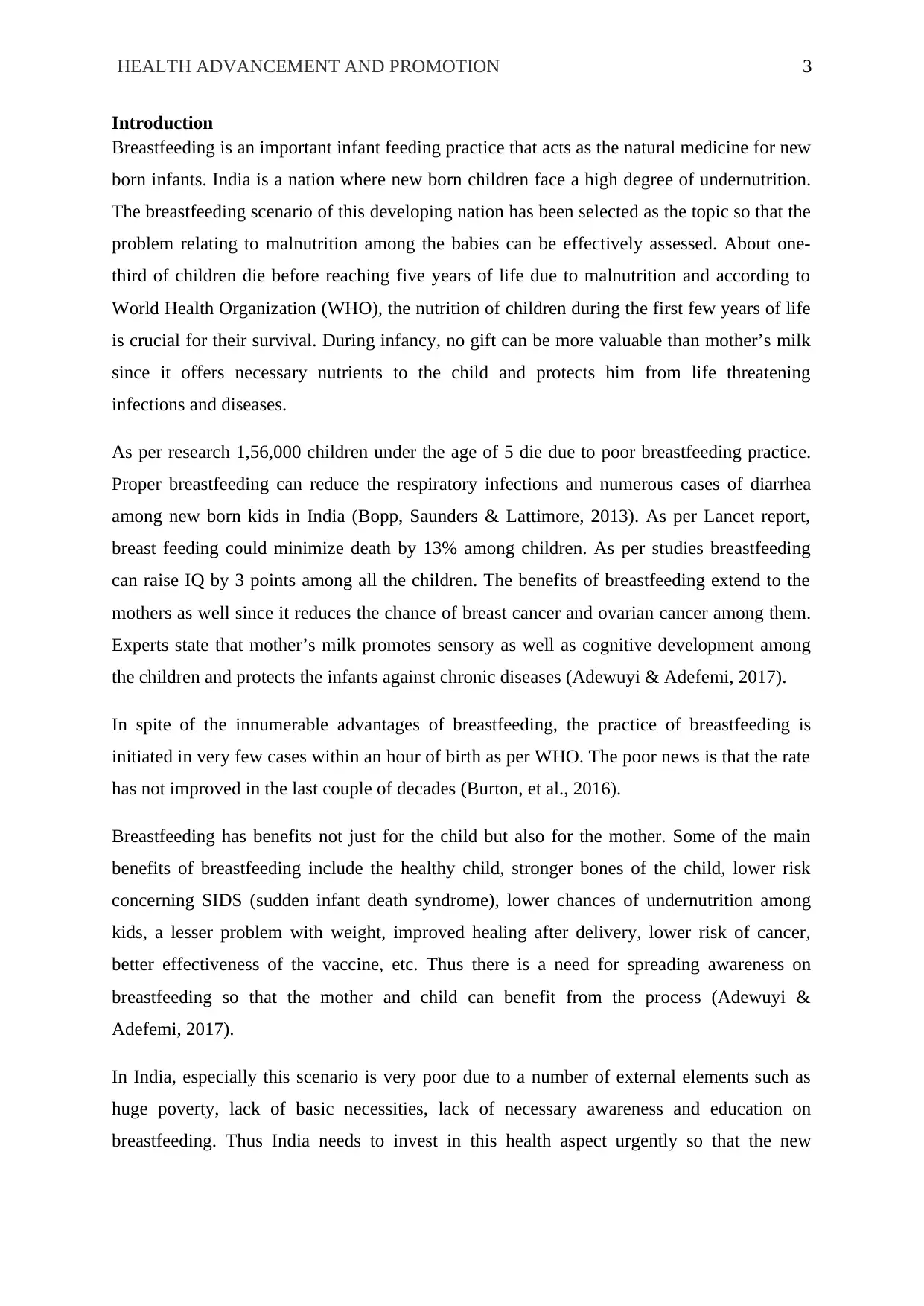
HEALTH ADVANCEMENT AND PROMOTION 3
Introduction
Breastfeeding is an important infant feeding practice that acts as the natural medicine for new
born infants. India is a nation where new born children face a high degree of undernutrition.
The breastfeeding scenario of this developing nation has been selected as the topic so that the
problem relating to malnutrition among the babies can be effectively assessed. About one-
third of children die before reaching five years of life due to malnutrition and according to
World Health Organization (WHO), the nutrition of children during the first few years of life
is crucial for their survival. During infancy, no gift can be more valuable than mother’s milk
since it offers necessary nutrients to the child and protects him from life threatening
infections and diseases.
As per research 1,56,000 children under the age of 5 die due to poor breastfeeding practice.
Proper breastfeeding can reduce the respiratory infections and numerous cases of diarrhea
among new born kids in India (Bopp, Saunders & Lattimore, 2013). As per Lancet report,
breast feeding could minimize death by 13% among children. As per studies breastfeeding
can raise IQ by 3 points among all the children. The benefits of breastfeeding extend to the
mothers as well since it reduces the chance of breast cancer and ovarian cancer among them.
Experts state that mother’s milk promotes sensory as well as cognitive development among
the children and protects the infants against chronic diseases (Adewuyi & Adefemi, 2017).
In spite of the innumerable advantages of breastfeeding, the practice of breastfeeding is
initiated in very few cases within an hour of birth as per WHO. The poor news is that the rate
has not improved in the last couple of decades (Burton, et al., 2016).
Breastfeeding has benefits not just for the child but also for the mother. Some of the main
benefits of breastfeeding include the healthy child, stronger bones of the child, lower risk
concerning SIDS (sudden infant death syndrome), lower chances of undernutrition among
kids, a lesser problem with weight, improved healing after delivery, lower risk of cancer,
better effectiveness of the vaccine, etc. Thus there is a need for spreading awareness on
breastfeeding so that the mother and child can benefit from the process (Adewuyi &
Adefemi, 2017).
In India, especially this scenario is very poor due to a number of external elements such as
huge poverty, lack of basic necessities, lack of necessary awareness and education on
breastfeeding. Thus India needs to invest in this health aspect urgently so that the new
Introduction
Breastfeeding is an important infant feeding practice that acts as the natural medicine for new
born infants. India is a nation where new born children face a high degree of undernutrition.
The breastfeeding scenario of this developing nation has been selected as the topic so that the
problem relating to malnutrition among the babies can be effectively assessed. About one-
third of children die before reaching five years of life due to malnutrition and according to
World Health Organization (WHO), the nutrition of children during the first few years of life
is crucial for their survival. During infancy, no gift can be more valuable than mother’s milk
since it offers necessary nutrients to the child and protects him from life threatening
infections and diseases.
As per research 1,56,000 children under the age of 5 die due to poor breastfeeding practice.
Proper breastfeeding can reduce the respiratory infections and numerous cases of diarrhea
among new born kids in India (Bopp, Saunders & Lattimore, 2013). As per Lancet report,
breast feeding could minimize death by 13% among children. As per studies breastfeeding
can raise IQ by 3 points among all the children. The benefits of breastfeeding extend to the
mothers as well since it reduces the chance of breast cancer and ovarian cancer among them.
Experts state that mother’s milk promotes sensory as well as cognitive development among
the children and protects the infants against chronic diseases (Adewuyi & Adefemi, 2017).
In spite of the innumerable advantages of breastfeeding, the practice of breastfeeding is
initiated in very few cases within an hour of birth as per WHO. The poor news is that the rate
has not improved in the last couple of decades (Burton, et al., 2016).
Breastfeeding has benefits not just for the child but also for the mother. Some of the main
benefits of breastfeeding include the healthy child, stronger bones of the child, lower risk
concerning SIDS (sudden infant death syndrome), lower chances of undernutrition among
kids, a lesser problem with weight, improved healing after delivery, lower risk of cancer,
better effectiveness of the vaccine, etc. Thus there is a need for spreading awareness on
breastfeeding so that the mother and child can benefit from the process (Adewuyi &
Adefemi, 2017).
In India, especially this scenario is very poor due to a number of external elements such as
huge poverty, lack of basic necessities, lack of necessary awareness and education on
breastfeeding. Thus India needs to invest in this health aspect urgently so that the new
⊘ This is a preview!⊘
Do you want full access?
Subscribe today to unlock all pages.

Trusted by 1+ million students worldwide
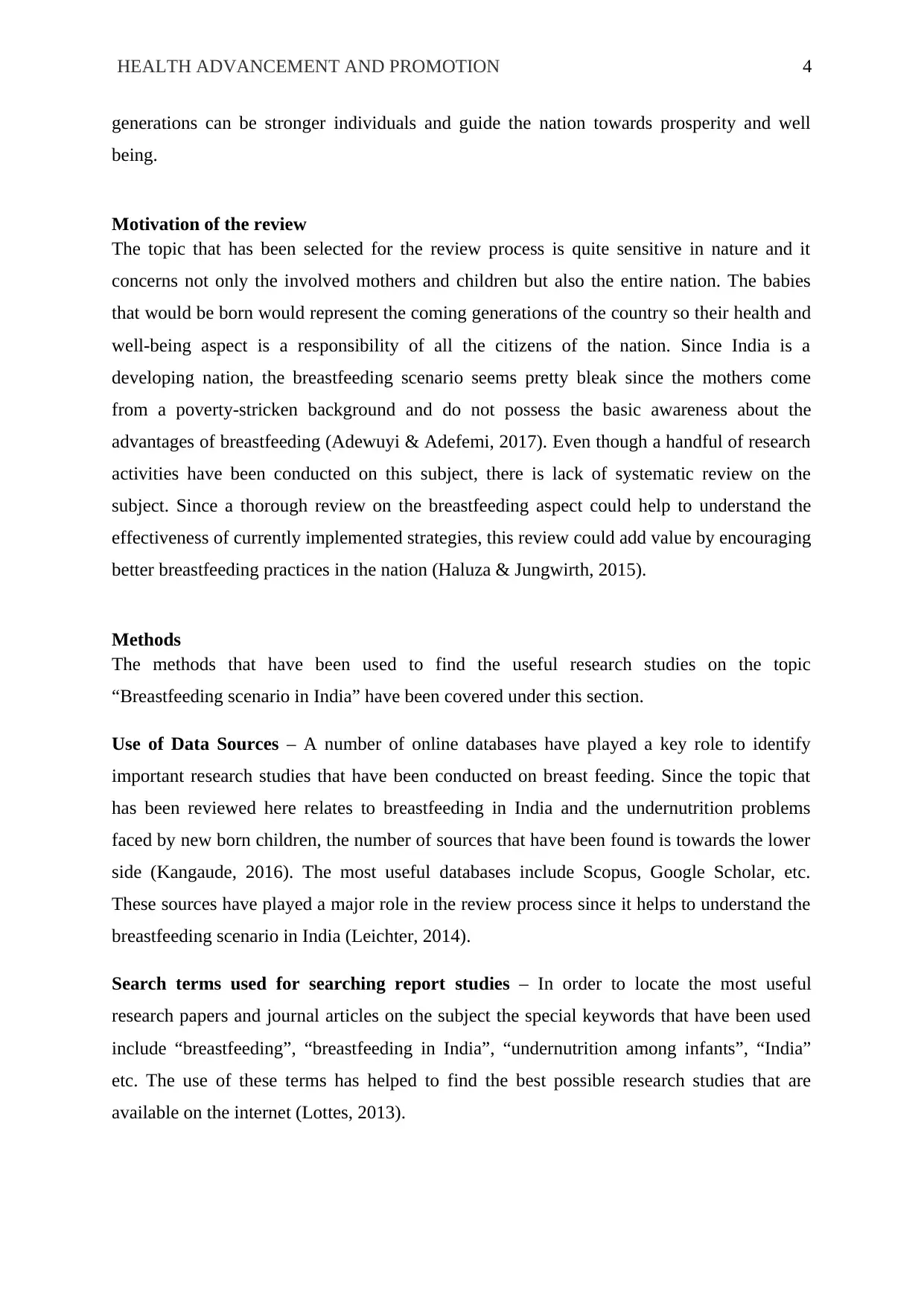
HEALTH ADVANCEMENT AND PROMOTION 4
generations can be stronger individuals and guide the nation towards prosperity and well
being.
Motivation of the review
The topic that has been selected for the review process is quite sensitive in nature and it
concerns not only the involved mothers and children but also the entire nation. The babies
that would be born would represent the coming generations of the country so their health and
well-being aspect is a responsibility of all the citizens of the nation. Since India is a
developing nation, the breastfeeding scenario seems pretty bleak since the mothers come
from a poverty-stricken background and do not possess the basic awareness about the
advantages of breastfeeding (Adewuyi & Adefemi, 2017). Even though a handful of research
activities have been conducted on this subject, there is lack of systematic review on the
subject. Since a thorough review on the breastfeeding aspect could help to understand the
effectiveness of currently implemented strategies, this review could add value by encouraging
better breastfeeding practices in the nation (Haluza & Jungwirth, 2015).
Methods
The methods that have been used to find the useful research studies on the topic
“Breastfeeding scenario in India” have been covered under this section.
Use of Data Sources – A number of online databases have played a key role to identify
important research studies that have been conducted on breast feeding. Since the topic that
has been reviewed here relates to breastfeeding in India and the undernutrition problems
faced by new born children, the number of sources that have been found is towards the lower
side (Kangaude, 2016). The most useful databases include Scopus, Google Scholar, etc.
These sources have played a major role in the review process since it helps to understand the
breastfeeding scenario in India (Leichter, 2014).
Search terms used for searching report studies – In order to locate the most useful
research papers and journal articles on the subject the special keywords that have been used
include “breastfeeding”, “breastfeeding in India”, “undernutrition among infants”, “India”
etc. The use of these terms has helped to find the best possible research studies that are
available on the internet (Lottes, 2013).
generations can be stronger individuals and guide the nation towards prosperity and well
being.
Motivation of the review
The topic that has been selected for the review process is quite sensitive in nature and it
concerns not only the involved mothers and children but also the entire nation. The babies
that would be born would represent the coming generations of the country so their health and
well-being aspect is a responsibility of all the citizens of the nation. Since India is a
developing nation, the breastfeeding scenario seems pretty bleak since the mothers come
from a poverty-stricken background and do not possess the basic awareness about the
advantages of breastfeeding (Adewuyi & Adefemi, 2017). Even though a handful of research
activities have been conducted on this subject, there is lack of systematic review on the
subject. Since a thorough review on the breastfeeding aspect could help to understand the
effectiveness of currently implemented strategies, this review could add value by encouraging
better breastfeeding practices in the nation (Haluza & Jungwirth, 2015).
Methods
The methods that have been used to find the useful research studies on the topic
“Breastfeeding scenario in India” have been covered under this section.
Use of Data Sources – A number of online databases have played a key role to identify
important research studies that have been conducted on breast feeding. Since the topic that
has been reviewed here relates to breastfeeding in India and the undernutrition problems
faced by new born children, the number of sources that have been found is towards the lower
side (Kangaude, 2016). The most useful databases include Scopus, Google Scholar, etc.
These sources have played a major role in the review process since it helps to understand the
breastfeeding scenario in India (Leichter, 2014).
Search terms used for searching report studies – In order to locate the most useful
research papers and journal articles on the subject the special keywords that have been used
include “breastfeeding”, “breastfeeding in India”, “undernutrition among infants”, “India”
etc. The use of these terms has helped to find the best possible research studies that are
available on the internet (Lottes, 2013).
Paraphrase This Document
Need a fresh take? Get an instant paraphrase of this document with our AI Paraphraser
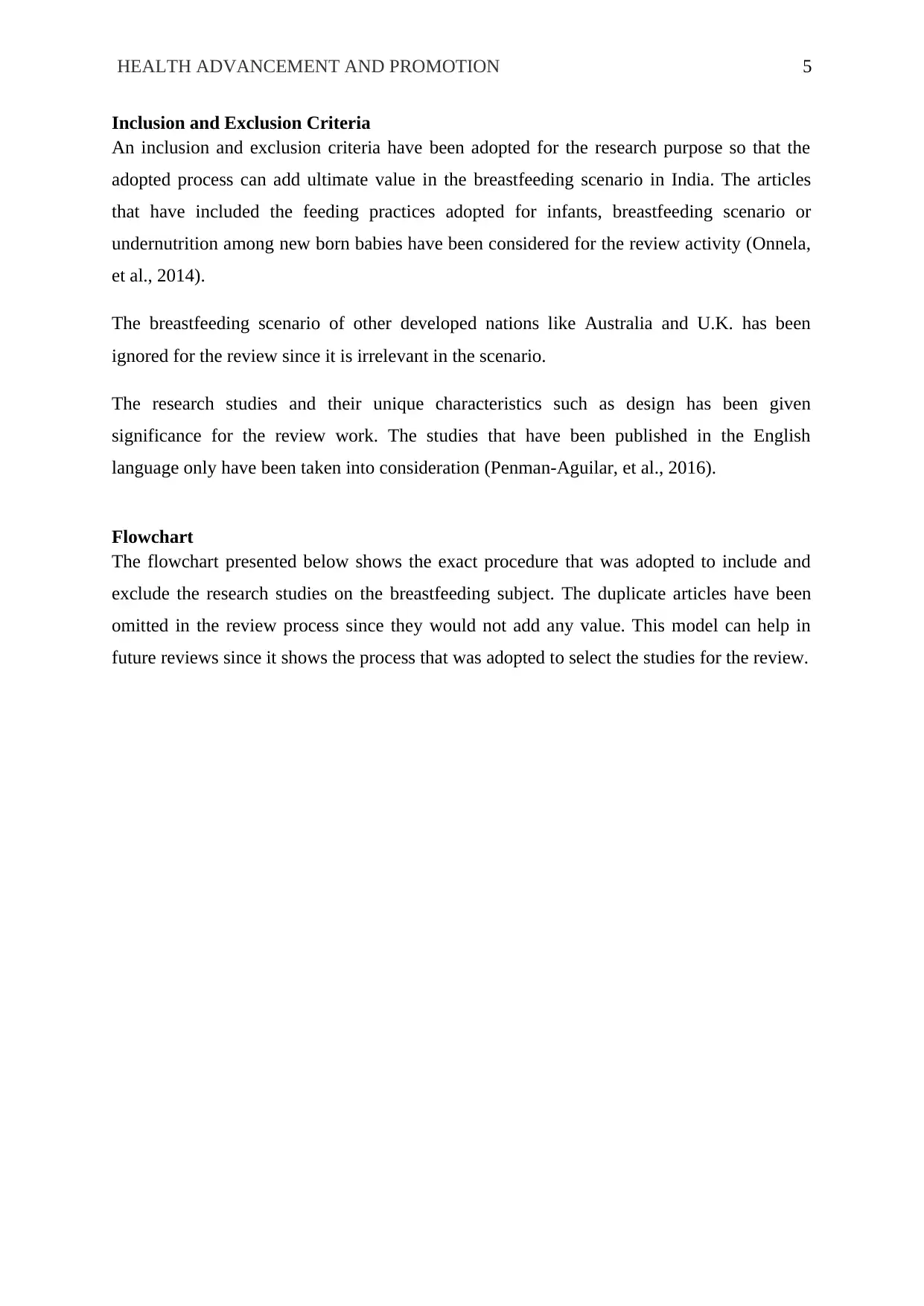
HEALTH ADVANCEMENT AND PROMOTION 5
Inclusion and Exclusion Criteria
An inclusion and exclusion criteria have been adopted for the research purpose so that the
adopted process can add ultimate value in the breastfeeding scenario in India. The articles
that have included the feeding practices adopted for infants, breastfeeding scenario or
undernutrition among new born babies have been considered for the review activity (Onnela,
et al., 2014).
The breastfeeding scenario of other developed nations like Australia and U.K. has been
ignored for the review since it is irrelevant in the scenario.
The research studies and their unique characteristics such as design has been given
significance for the review work. The studies that have been published in the English
language only have been taken into consideration (Penman-Aguilar, et al., 2016).
Flowchart
The flowchart presented below shows the exact procedure that was adopted to include and
exclude the research studies on the breastfeeding subject. The duplicate articles have been
omitted in the review process since they would not add any value. This model can help in
future reviews since it shows the process that was adopted to select the studies for the review.
Inclusion and Exclusion Criteria
An inclusion and exclusion criteria have been adopted for the research purpose so that the
adopted process can add ultimate value in the breastfeeding scenario in India. The articles
that have included the feeding practices adopted for infants, breastfeeding scenario or
undernutrition among new born babies have been considered for the review activity (Onnela,
et al., 2014).
The breastfeeding scenario of other developed nations like Australia and U.K. has been
ignored for the review since it is irrelevant in the scenario.
The research studies and their unique characteristics such as design has been given
significance for the review work. The studies that have been published in the English
language only have been taken into consideration (Penman-Aguilar, et al., 2016).
Flowchart
The flowchart presented below shows the exact procedure that was adopted to include and
exclude the research studies on the breastfeeding subject. The duplicate articles have been
omitted in the review process since they would not add any value. This model can help in
future reviews since it shows the process that was adopted to select the studies for the review.
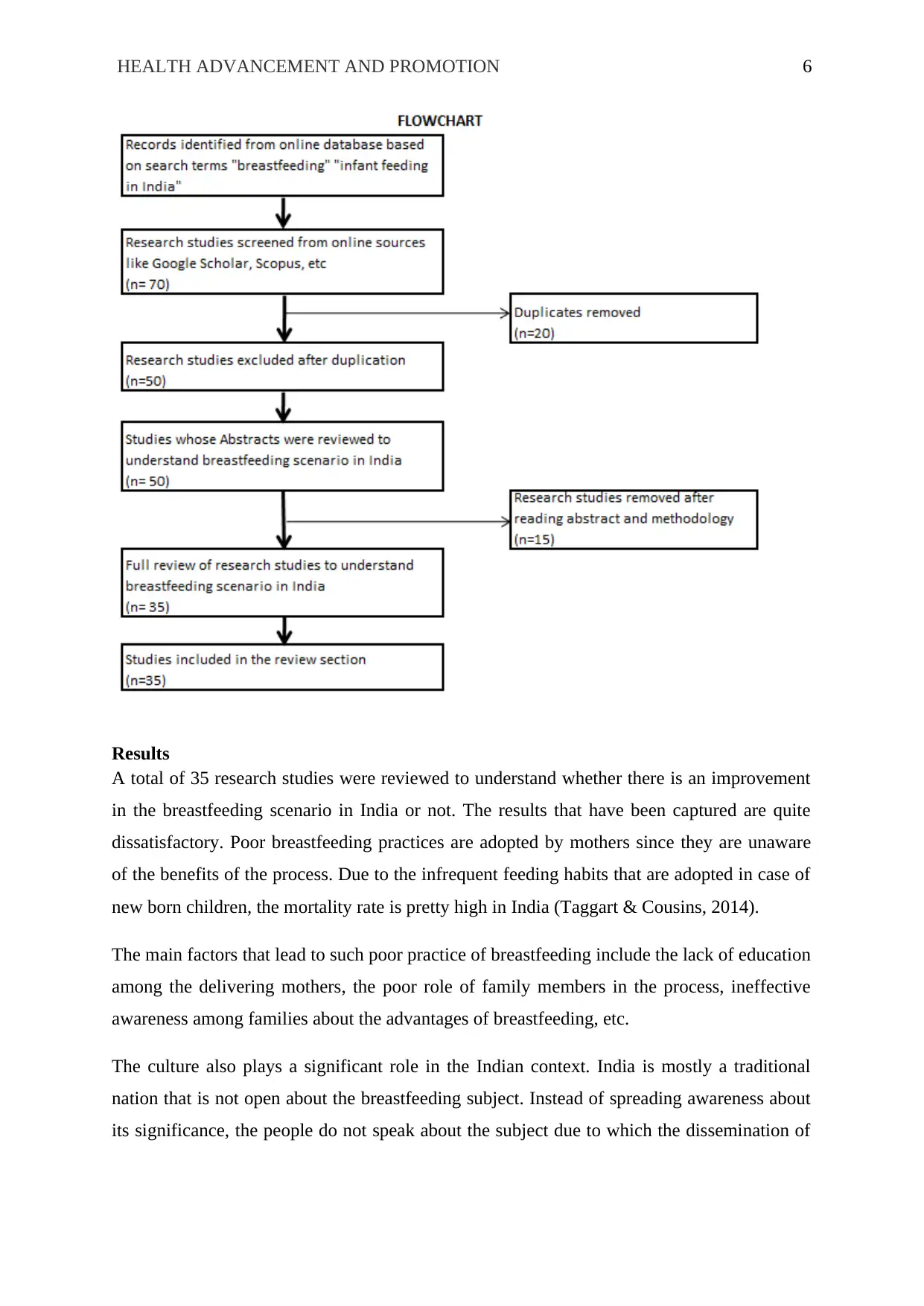
HEALTH ADVANCEMENT AND PROMOTION 6
Results
A total of 35 research studies were reviewed to understand whether there is an improvement
in the breastfeeding scenario in India or not. The results that have been captured are quite
dissatisfactory. Poor breastfeeding practices are adopted by mothers since they are unaware
of the benefits of the process. Due to the infrequent feeding habits that are adopted in case of
new born children, the mortality rate is pretty high in India (Taggart & Cousins, 2014).
The main factors that lead to such poor practice of breastfeeding include the lack of education
among the delivering mothers, the poor role of family members in the process, ineffective
awareness among families about the advantages of breastfeeding, etc.
The culture also plays a significant role in the Indian context. India is mostly a traditional
nation that is not open about the breastfeeding subject. Instead of spreading awareness about
its significance, the people do not speak about the subject due to which the dissemination of
Results
A total of 35 research studies were reviewed to understand whether there is an improvement
in the breastfeeding scenario in India or not. The results that have been captured are quite
dissatisfactory. Poor breastfeeding practices are adopted by mothers since they are unaware
of the benefits of the process. Due to the infrequent feeding habits that are adopted in case of
new born children, the mortality rate is pretty high in India (Taggart & Cousins, 2014).
The main factors that lead to such poor practice of breastfeeding include the lack of education
among the delivering mothers, the poor role of family members in the process, ineffective
awareness among families about the advantages of breastfeeding, etc.
The culture also plays a significant role in the Indian context. India is mostly a traditional
nation that is not open about the breastfeeding subject. Instead of spreading awareness about
its significance, the people do not speak about the subject due to which the dissemination of
⊘ This is a preview!⊘
Do you want full access?
Subscribe today to unlock all pages.

Trusted by 1+ million students worldwide
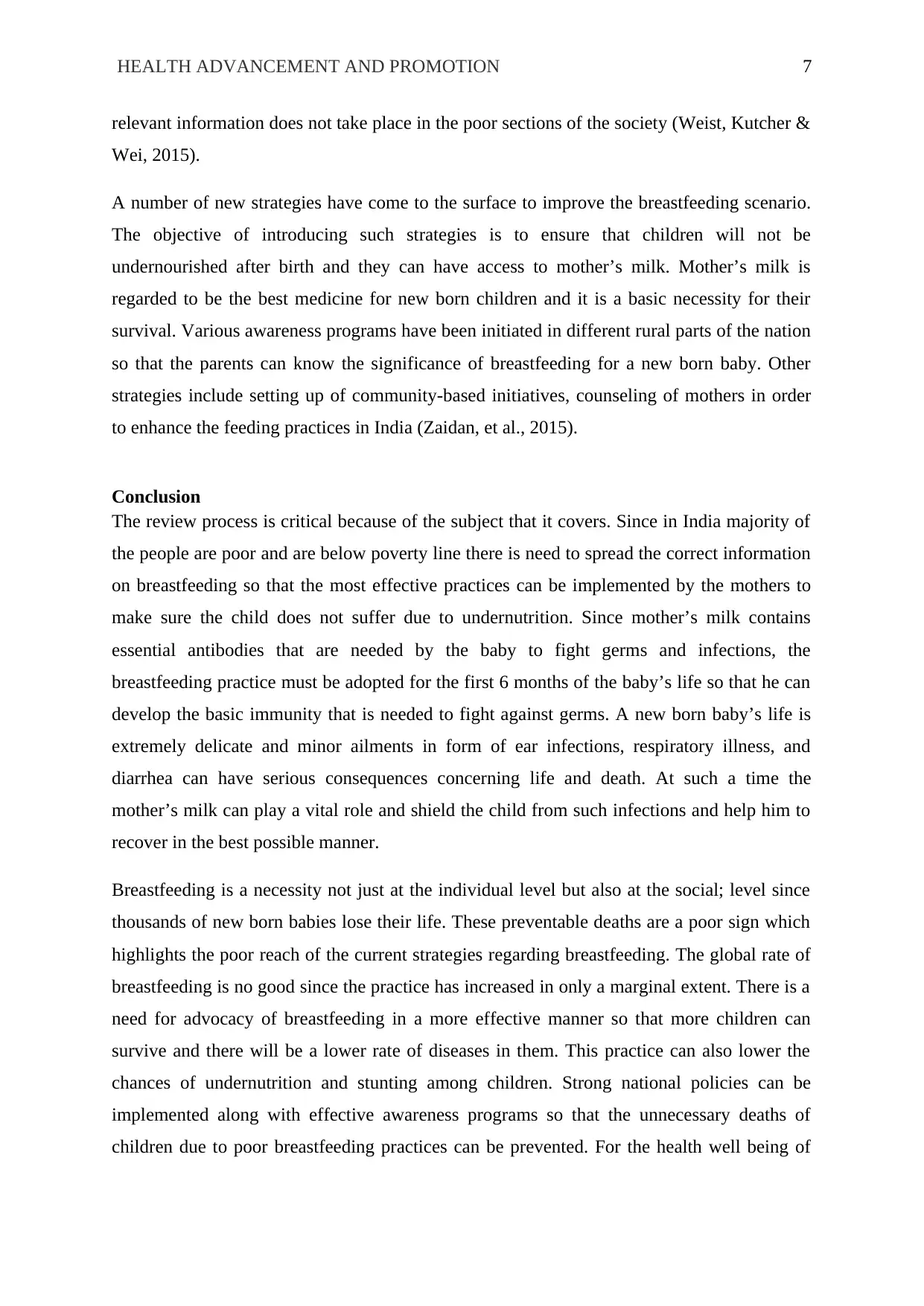
HEALTH ADVANCEMENT AND PROMOTION 7
relevant information does not take place in the poor sections of the society (Weist, Kutcher &
Wei, 2015).
A number of new strategies have come to the surface to improve the breastfeeding scenario.
The objective of introducing such strategies is to ensure that children will not be
undernourished after birth and they can have access to mother’s milk. Mother’s milk is
regarded to be the best medicine for new born children and it is a basic necessity for their
survival. Various awareness programs have been initiated in different rural parts of the nation
so that the parents can know the significance of breastfeeding for a new born baby. Other
strategies include setting up of community-based initiatives, counseling of mothers in order
to enhance the feeding practices in India (Zaidan, et al., 2015).
Conclusion
The review process is critical because of the subject that it covers. Since in India majority of
the people are poor and are below poverty line there is need to spread the correct information
on breastfeeding so that the most effective practices can be implemented by the mothers to
make sure the child does not suffer due to undernutrition. Since mother’s milk contains
essential antibodies that are needed by the baby to fight germs and infections, the
breastfeeding practice must be adopted for the first 6 months of the baby’s life so that he can
develop the basic immunity that is needed to fight against germs. A new born baby’s life is
extremely delicate and minor ailments in form of ear infections, respiratory illness, and
diarrhea can have serious consequences concerning life and death. At such a time the
mother’s milk can play a vital role and shield the child from such infections and help him to
recover in the best possible manner.
Breastfeeding is a necessity not just at the individual level but also at the social; level since
thousands of new born babies lose their life. These preventable deaths are a poor sign which
highlights the poor reach of the current strategies regarding breastfeeding. The global rate of
breastfeeding is no good since the practice has increased in only a marginal extent. There is a
need for advocacy of breastfeeding in a more effective manner so that more children can
survive and there will be a lower rate of diseases in them. This practice can also lower the
chances of undernutrition and stunting among children. Strong national policies can be
implemented along with effective awareness programs so that the unnecessary deaths of
children due to poor breastfeeding practices can be prevented. For the health well being of
relevant information does not take place in the poor sections of the society (Weist, Kutcher &
Wei, 2015).
A number of new strategies have come to the surface to improve the breastfeeding scenario.
The objective of introducing such strategies is to ensure that children will not be
undernourished after birth and they can have access to mother’s milk. Mother’s milk is
regarded to be the best medicine for new born children and it is a basic necessity for their
survival. Various awareness programs have been initiated in different rural parts of the nation
so that the parents can know the significance of breastfeeding for a new born baby. Other
strategies include setting up of community-based initiatives, counseling of mothers in order
to enhance the feeding practices in India (Zaidan, et al., 2015).
Conclusion
The review process is critical because of the subject that it covers. Since in India majority of
the people are poor and are below poverty line there is need to spread the correct information
on breastfeeding so that the most effective practices can be implemented by the mothers to
make sure the child does not suffer due to undernutrition. Since mother’s milk contains
essential antibodies that are needed by the baby to fight germs and infections, the
breastfeeding practice must be adopted for the first 6 months of the baby’s life so that he can
develop the basic immunity that is needed to fight against germs. A new born baby’s life is
extremely delicate and minor ailments in form of ear infections, respiratory illness, and
diarrhea can have serious consequences concerning life and death. At such a time the
mother’s milk can play a vital role and shield the child from such infections and help him to
recover in the best possible manner.
Breastfeeding is a necessity not just at the individual level but also at the social; level since
thousands of new born babies lose their life. These preventable deaths are a poor sign which
highlights the poor reach of the current strategies regarding breastfeeding. The global rate of
breastfeeding is no good since the practice has increased in only a marginal extent. There is a
need for advocacy of breastfeeding in a more effective manner so that more children can
survive and there will be a lower rate of diseases in them. This practice can also lower the
chances of undernutrition and stunting among children. Strong national policies can be
implemented along with effective awareness programs so that the unnecessary deaths of
children due to poor breastfeeding practices can be prevented. For the health well being of
Paraphrase This Document
Need a fresh take? Get an instant paraphrase of this document with our AI Paraphraser
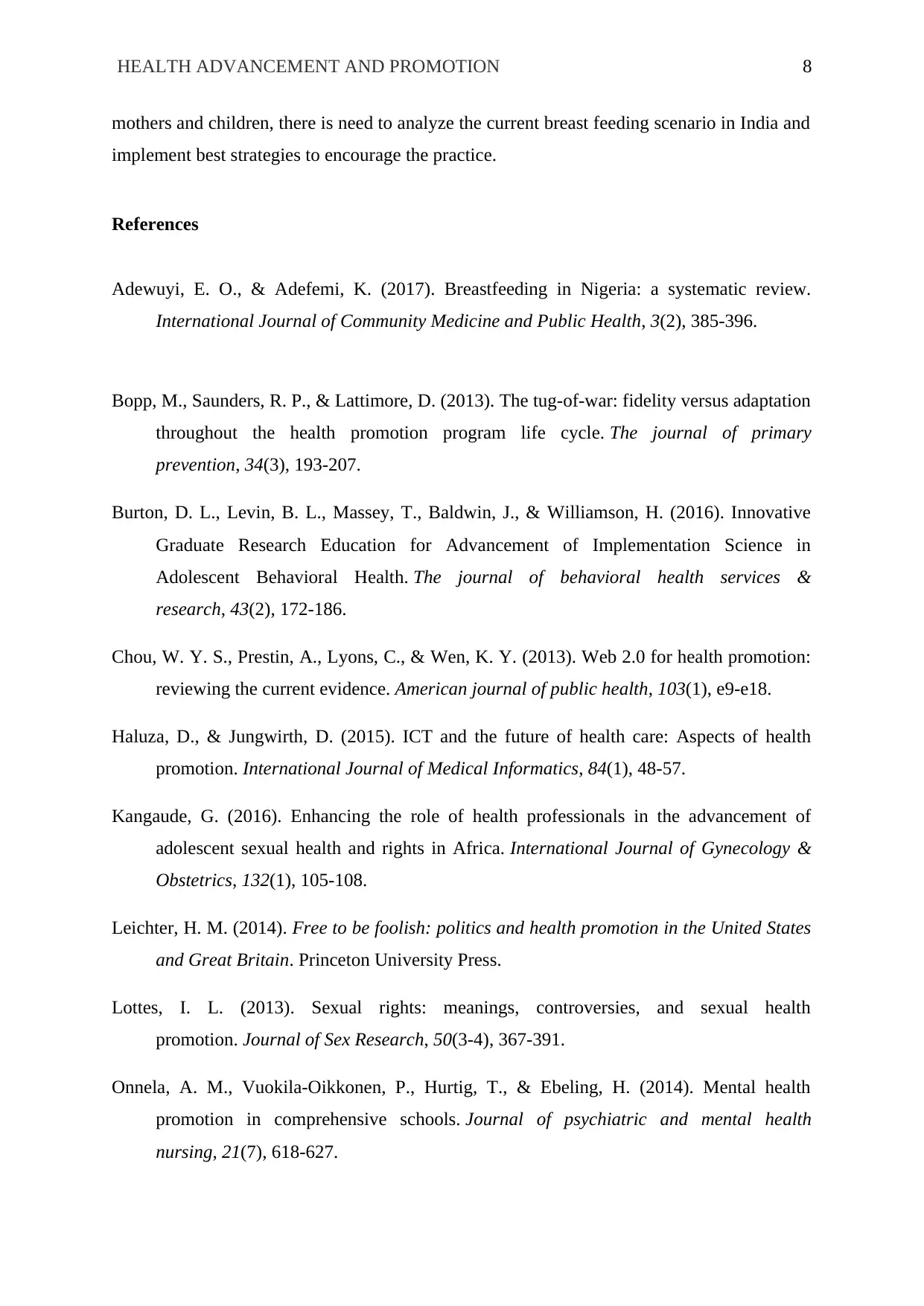
HEALTH ADVANCEMENT AND PROMOTION 8
mothers and children, there is need to analyze the current breast feeding scenario in India and
implement best strategies to encourage the practice.
References
Adewuyi, E. O., & Adefemi, K. (2017). Breastfeeding in Nigeria: a systematic review.
International Journal of Community Medicine and Public Health, 3(2), 385-396.
Bopp, M., Saunders, R. P., & Lattimore, D. (2013). The tug-of-war: fidelity versus adaptation
throughout the health promotion program life cycle. The journal of primary
prevention, 34(3), 193-207.
Burton, D. L., Levin, B. L., Massey, T., Baldwin, J., & Williamson, H. (2016). Innovative
Graduate Research Education for Advancement of Implementation Science in
Adolescent Behavioral Health. The journal of behavioral health services &
research, 43(2), 172-186.
Chou, W. Y. S., Prestin, A., Lyons, C., & Wen, K. Y. (2013). Web 2.0 for health promotion:
reviewing the current evidence. American journal of public health, 103(1), e9-e18.
Haluza, D., & Jungwirth, D. (2015). ICT and the future of health care: Aspects of health
promotion. International Journal of Medical Informatics, 84(1), 48-57.
Kangaude, G. (2016). Enhancing the role of health professionals in the advancement of
adolescent sexual health and rights in Africa. International Journal of Gynecology &
Obstetrics, 132(1), 105-108.
Leichter, H. M. (2014). Free to be foolish: politics and health promotion in the United States
and Great Britain. Princeton University Press.
Lottes, I. L. (2013). Sexual rights: meanings, controversies, and sexual health
promotion. Journal of Sex Research, 50(3-4), 367-391.
Onnela, A. M., Vuokila‐Oikkonen, P., Hurtig, T., & Ebeling, H. (2014). Mental health
promotion in comprehensive schools. Journal of psychiatric and mental health
nursing, 21(7), 618-627.
mothers and children, there is need to analyze the current breast feeding scenario in India and
implement best strategies to encourage the practice.
References
Adewuyi, E. O., & Adefemi, K. (2017). Breastfeeding in Nigeria: a systematic review.
International Journal of Community Medicine and Public Health, 3(2), 385-396.
Bopp, M., Saunders, R. P., & Lattimore, D. (2013). The tug-of-war: fidelity versus adaptation
throughout the health promotion program life cycle. The journal of primary
prevention, 34(3), 193-207.
Burton, D. L., Levin, B. L., Massey, T., Baldwin, J., & Williamson, H. (2016). Innovative
Graduate Research Education for Advancement of Implementation Science in
Adolescent Behavioral Health. The journal of behavioral health services &
research, 43(2), 172-186.
Chou, W. Y. S., Prestin, A., Lyons, C., & Wen, K. Y. (2013). Web 2.0 for health promotion:
reviewing the current evidence. American journal of public health, 103(1), e9-e18.
Haluza, D., & Jungwirth, D. (2015). ICT and the future of health care: Aspects of health
promotion. International Journal of Medical Informatics, 84(1), 48-57.
Kangaude, G. (2016). Enhancing the role of health professionals in the advancement of
adolescent sexual health and rights in Africa. International Journal of Gynecology &
Obstetrics, 132(1), 105-108.
Leichter, H. M. (2014). Free to be foolish: politics and health promotion in the United States
and Great Britain. Princeton University Press.
Lottes, I. L. (2013). Sexual rights: meanings, controversies, and sexual health
promotion. Journal of Sex Research, 50(3-4), 367-391.
Onnela, A. M., Vuokila‐Oikkonen, P., Hurtig, T., & Ebeling, H. (2014). Mental health
promotion in comprehensive schools. Journal of psychiatric and mental health
nursing, 21(7), 618-627.
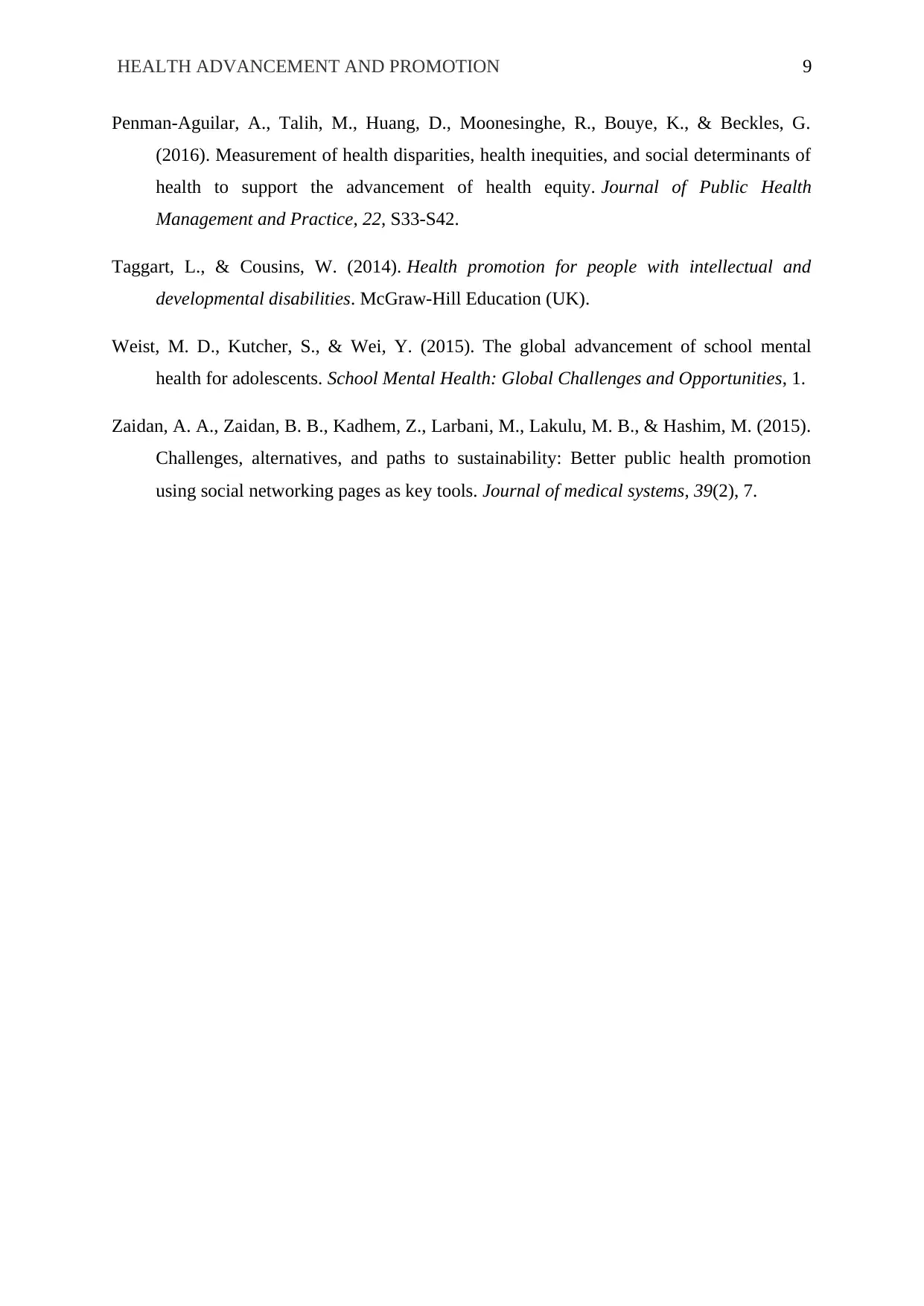
HEALTH ADVANCEMENT AND PROMOTION 9
Penman-Aguilar, A., Talih, M., Huang, D., Moonesinghe, R., Bouye, K., & Beckles, G.
(2016). Measurement of health disparities, health inequities, and social determinants of
health to support the advancement of health equity. Journal of Public Health
Management and Practice, 22, S33-S42.
Taggart, L., & Cousins, W. (2014). Health promotion for people with intellectual and
developmental disabilities. McGraw-Hill Education (UK).
Weist, M. D., Kutcher, S., & Wei, Y. (2015). The global advancement of school mental
health for adolescents. School Mental Health: Global Challenges and Opportunities, 1.
Zaidan, A. A., Zaidan, B. B., Kadhem, Z., Larbani, M., Lakulu, M. B., & Hashim, M. (2015).
Challenges, alternatives, and paths to sustainability: Better public health promotion
using social networking pages as key tools. Journal of medical systems, 39(2), 7.
Penman-Aguilar, A., Talih, M., Huang, D., Moonesinghe, R., Bouye, K., & Beckles, G.
(2016). Measurement of health disparities, health inequities, and social determinants of
health to support the advancement of health equity. Journal of Public Health
Management and Practice, 22, S33-S42.
Taggart, L., & Cousins, W. (2014). Health promotion for people with intellectual and
developmental disabilities. McGraw-Hill Education (UK).
Weist, M. D., Kutcher, S., & Wei, Y. (2015). The global advancement of school mental
health for adolescents. School Mental Health: Global Challenges and Opportunities, 1.
Zaidan, A. A., Zaidan, B. B., Kadhem, Z., Larbani, M., Lakulu, M. B., & Hashim, M. (2015).
Challenges, alternatives, and paths to sustainability: Better public health promotion
using social networking pages as key tools. Journal of medical systems, 39(2), 7.
⊘ This is a preview!⊘
Do you want full access?
Subscribe today to unlock all pages.

Trusted by 1+ million students worldwide
1 out of 9
Related Documents
Your All-in-One AI-Powered Toolkit for Academic Success.
+13062052269
info@desklib.com
Available 24*7 on WhatsApp / Email
![[object Object]](/_next/static/media/star-bottom.7253800d.svg)
Unlock your academic potential
Copyright © 2020–2025 A2Z Services. All Rights Reserved. Developed and managed by ZUCOL.





